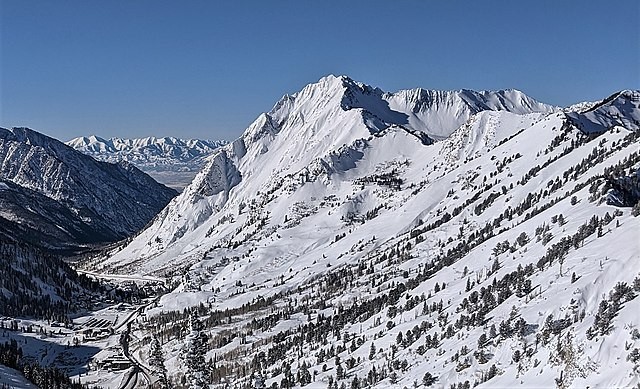Wasatch Front mayors hold their noses and swallow the Little Cottonwood gondola
Snow Job
By Benjamin Wood @BjaminWoodDEPOT DISTRICT—Members of the Wasatch Front Regional Council—a conclave of city mayors, county commissioners and state transportation officials—voted unanimously on Thursday to adopt a new regional transportation plan for northern Utah, one that includes construction of a controversial gondola in Little Cottonwood Canyon.
That vote followed debate over the council's ability to reject the gondola plan—developed by the Utah Department of Transportation to move skiers, exclusively, to two private resorts, exclusively—including an unsuccessful push by Salt Lake County Mayor Jenny Wilson to accept only UDOT's initial busing and tolling phases for canyon traffic. But Millcreek Mayor Jeff Silvestrini argued that federal rules require the WFRC to include the totality of UDOT's environmental impact documents as-is, or else risk delaying more than 1,000 other road, transit and trails projects set to break ground in the state's population centers.
"These projects address congestion and mitigation of that congestion," Silvestrini said. "They address transit improvement and they address air quality."
But Wilson questioned when, if not now, elected officials would be in a position to address the overwhelming gondola opposition received from their constituents. A vocal gondola opponent, Wilson said council members were told to allow the project to advance to the public comment stage, only to be told after receiving thousands of statements of public opposition that their hands are now tied.
"We’re saying now we can’t [deny the gondola plan], we’re bound to this legal review," she said. "I think bureaucracy is winning, and that’s very disappointing to me."
A capacity crowd was present for Thursday's vote, with an overwhelming majority of those offering public comment speaking against the construction of the gondola, which will not include any service to lower-canyon trailheads, nor will it carry riders to the popular Oktoberfest at Snowbird or other off-season resort activities. Nathan Rafferty, president of Ski Utah, spoke in favor.
"There’s no silver bullet solution," he said. "If that was the case, we would have solved this issue a long time ago."
Patrick Shea, a prominent Salt Lake lawyer and academic, spoke against the gondola and stated that he would engage in civil disobedience to protest the project. He then stood silently in the center of the room for the duration of public comment and into some of the council debate, until council chairwoman (and South Jordan Mayor) Dawn Ramsay ordered his removal from the room, at which he point he peacefully complied, to cheers and applause from the crowd.
But gondola skeptics did win a small concession from the regional council, which adopted a formal statement supporting only the initial bus and tolling (phases 1 and 2) of the gondola project and emphasizing that construction of the gondola itself (phase 3) should only occur after implementation and review of those short-term efforts to ease traffic congestion.
"It should not be interpreted by anyone that this is a done deal," said Sandy Mayor Monica Zoltanski, whose previous effort to deny the gondola plans failed in a regional council subcommittee on a narrow 6-5 vote.
UDOT executive director Carlos Braceras said the highway department is comfortable with the council's bus-first statement, adding that it reflects UDOT's own long-rang planning, which expects to develop express buses, private vehicle tolling and avalanche sheds prior to construction of the gondola. Notably, the express busing envisioned by UDOT would also exclude lower-canyon destinations and non-winter use, as a spokesman told City Weekly that any transit stops outside the ski resorts would make the service less appealing to the skiers who would otherwise choose to drive.
"We’ll be able to proceed as quickly as possible to implement those [phase 1 and 2] solutions," Braceras said. "We’re excited to be able to do something that will absolutely make a difference."
Following the vote to approve UDOT's plans, Ramsay attempted to explain her vote to those in attendance, saying she and her council colleagues have a responsibility to the entire region's transportation needs. She emphasized that WFRC was neither endorsing the gondola nor allocating funding for it—that task has already been performed by the state Legislature, with little oversight over UDOT's project specifics—and that northern Utah's regional transportation plan will continue to be updated on a rolling 4-year basis.
"It may not feel like you’ve been heard, but I want you to know we have heard you," she said. "This is a living plan. This is a living document."
More by Benjamin Wood
-
‘Festival street,' Green Loop and transit-oriented density anchor latest SLC plans for west downtown.
Arrested Development
- Apr 17, 2024
-
Former Salt Lake City mayor and celebrated Utah Democrat Ted Wilson dies at age 84.
Ted Led
- Apr 11, 2024
-
Salt Lakers are about to miss an opportunity for reconnection over and under I-15.
Small Lake City
- Mar 27, 2024
- More »
Latest in News
Readers also liked…
-
Raise a glass for E.L.T Harrison, architect of the Beerhive building on Main
Small Lake City
- Oct 11, 2023




